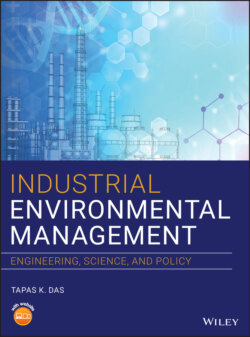Читать книгу Industrial Environmental Management - Tapas K. Das - Страница 67
2.4.1 Mini Case Studies
ОглавлениеIndustrialization and urbanization, as a result of Industrial Revolution, began long before the late nineteenth and early twentieth centuries, but it accelerated greatly during this period because of technological innovations, social changes, and a political system increasingly apt to favor economic growth beyond any other concern. Before 1880, industrialization depended upon a prescribed division of labor – breaking most jobs up into smaller tasks, and assigning the same people to repeat one task indefinitely. After 1880, industrialization depended much more on mechanization – the replacement of people with machines – to increase production and maximize profits. The development of the modern electrical grid, starting in the early 1880s, facilitated such technological advances. Henry Ford's assembly line and the rise of mass production after the turn of the twentieth century only strengthened this effect. As a result, the total manufacturing output of the United States was 28 times greater in 1929 than it was 1859. Adjust that number for the growth in population over the same period, and it still multiplied seven times over (Wright 1941).
Cities in America date back to the beginning of the colonial period, but the tendency for new industrial factories to be located in or near urban areas meant that cities grew much faster during the late nineteenth century than ever before. This trend was most apparent in large cities like New York, which expanded from approximately half a million to around 3.5 million people between 1850 and 1900, and Philadelphia, which increased in size from slightly more than 100 000 inhabitants to more than 1.2 million people over the same period. During the last half of the late nineteenth century, Chicago proved to be the fastest growing city in the world. Overall, 15.3% of Americans lived in cities in 1850. By 1900, that percentage had increased to 39.7, and kept growing. The 1920 Census revealed that more Americans lived in cities than the countryside for the first time (Rees 2013).
Not every city in the country developed as fast as the largest cities did. Important regional differences existed in urbanization because of differences in the nature of industrial growth. The largest cities in the Northeast were manufacturing powerhouses that contained everything, from large factories building railroad locomotives to small shops producing textiles in people's apartments. The Northeast also gave rise to smaller cities that concentrated on particular industries, like Rochester, New York, which specialized in men's clothing, boots, and shoes. Following on a tradition of manufacturing from earlier in the century, New Bedford and Fall River, Massachusetts, increased in size because of their cotton textile factories. Other cities, like Elizabeth, New Jersey, grew as by‐products of the expansion of their larger neighbors.
Chicago, the largest city in the Midwest, made its name processing natural resources from the Western frontier before those resources traveled eastward as finished products. Grain and lumber – two industries that had been crucial for Chicago's early growth – relied on Chicago for marketing and storage. With perfection of the refrigerated railroad car, meat processing became such an enormous industry that the vast majority of the meat that Americans ate was processed in the stockyards on that city's south side. (That activity would disperse again, after the turn of the twentieth century, to other cities like Fort Worth and Kansas City.) Smaller cities in America's industrial heartland would grow around other manufacturing pursuits like steel in Youngstown, and machine tools and cash registers in Dayton, Ohio (Warner 1995).
The South had lagged behind the rest of the country since before the Civil War. As a result, many advocates for outside investment in this region expanded their activities after the war. They were somewhat successful. While the rate of industrialization (and therefore urbanization) picked up in the South during the late nineteenth and early twentieth centuries, it still has not fully caught up with the rest of the country. Birmingham, Alabama, for example, founded in 1871, flourished as a center for iron and steel manufacturing during the 1880s, when two railroads first linked that city to the region's mineral resources (Misa 1999). The growth of cotton mills in the “upcountry” section of the Carolinas began during the 1870s. After the turn of the twentieth century, this region became an important center of activity for the textile industry, in large part because of the available cheap, nonunion labor.
What separates this period from earlier periods in urban and industrial history is that this was the first time in American history that cities had moved to the center of American life. Cities were places where most of the new factories were built. Waves of immigrants settled in cities because that is where the job openings in industrial factories were. Cities were also places where the effects of industrialization, especially the increased inequality of wealth, were most visible. That means that the problems of cities became the problems of America.
